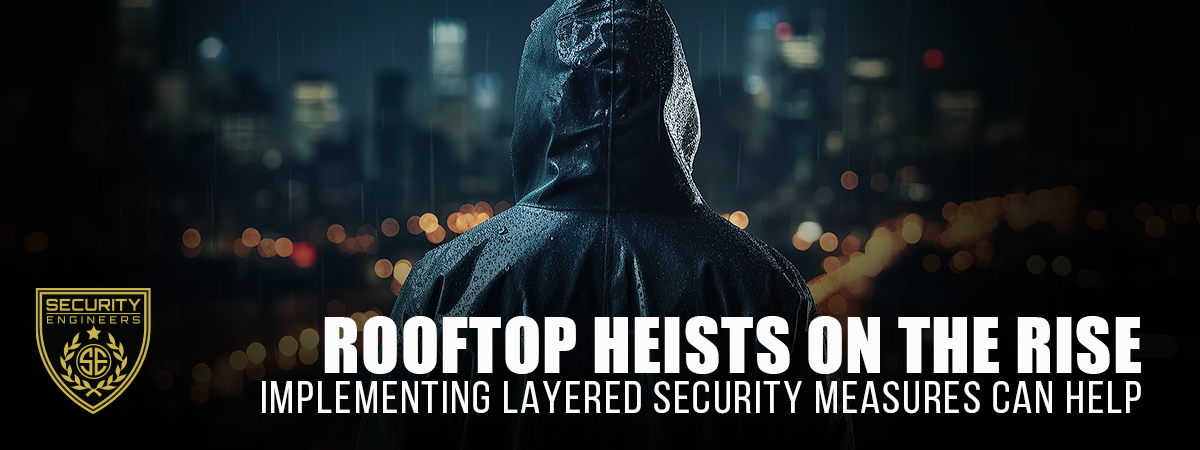
Rooftop heists, often glamorized in movies and novels, have become a grim reality in many urban landscapes. These daring burglaries involve criminals gaining access to buildings via rooftops, bypassing conventional security measures. From valuable merchandise in commercial buildings to personal belongings in residential complexes, no property seems immune to the threat of rooftop heists. However, with careful planning and implementation of robust security measures, property owners can significantly reduce the risk of such incidents.
- Perimeter Security: The first line of defense against rooftop heists is securing the perimeter of the building. Installing sturdy fences, gates, and barriers can deter unauthorized individuals from accessing the premises. Additionally, strategic placement of security cameras, motion sensors and laser detectors can be installed to detect any breaches and alert security personnel. Regular patrols by security guards further enhance vigilance and deter potential intruders.
- Access Control Systems: Implementing access control systems is crucial in restricting entry to authorized personnel only. Keycard access, biometric scanners, or keypad entry systems can effectively control who enters the building and at what times. Restricting access to stairwells and elevator shafts leading to the rooftop can prevent unauthorized individuals from reaching vulnerable entry points.
- Surveillance Systems: Installing high-definition cameras strategically across rooftops provides adequate coverage and serves as a deterrent to potential thieves. These cameras, equipped with night vision and motion detection capabilities, offer real-time monitoring and recording of suspicious activities. Visible cameras act as a psychological barrier to criminals, while hidden cameras can provide discreet monitoring of sensitive areas. Moreover, integrating these cameras with motion detection and remote monitoring capabilities allows for swift response to suspicious activities. Coupled with analytics software, they can identify unauthorized access and trigger immediate alerts to security personnel.
- Alarms and Sensors: Installing alarms and sensors on rooftop access points can immediately alert security personnel or law enforcement authorities to unauthorized entry attempts. Motion sensors, glass-break detectors, and door/window alarms can trigger instant alerts, prompting rapid intervention before criminals can execute their plans.
- Physical Barriers and Reinforcements: Strengthening rooftop access points with physical barriers such as locked gates, reinforced doors, and tamper-resistant locks can impede unauthorized entry attempts. Additionally, installing anti-climb measures like barbed wire or spike strips along rooftop edges can further deter intruders from accessing the building from above.
- Security Personnel: Employing trained security personnel to patrol the premises, particularly during vulnerable hours, adds an extra layer of protection against rooftop heists. Their presence not only acts as a visible deterrent but also enables proactive response to any security breaches or suspicious activities.
- Lighting: Adequate lighting plays a crucial role in deterring criminal activities, particularly during nighttime. Illuminating rooftop areas with bright, motion-activated lights eliminates dark hiding spots and increases visibility for security cameras. Strategic placement of lights along access points and vulnerable areas minimizes blind spots and enhances overall security.
- Alarm Systems: Implementing alarm systems specifically designed for rooftop security adds an extra layer of protection. These systems can include perimeter alarms, glass break sensors, and vibration detectors to detect any unauthorized entry attempts. Integrating alarms with centralized monitoring stations provides prompt response and intervention in the event of an emergency.
- Training and Awareness: Educating building occupants and staff about the importance of rooftop security and encouraging them to report any suspicious activities fosters a culture of vigilance. Conducting regular security awareness training sessions equips personnel with the knowledge and skills to identify potential threats and respond effectively in emergency situations.
- Collaboration with Law Enforcement: Establishing partnerships with local law enforcement agencies facilitates information sharing and coordination in crime prevention efforts. Collaborative initiatives such as joint patrols, intelligence sharing, and crime analysis help identify emerging trends and implement targeted security measures to mitigate risks effectively.
- Community Collaboration: Building strong relationships with neighboring businesses, residents, and law enforcement agencies fosters a collaborative approach to security. Sharing information about potential threats or suspicious individuals in the area can help preemptively thwart rooftop heists and other criminal activities.
- Regular Security Audits and Upgrades: Conducting routine security audits allows property owners to identify vulnerabilities and implement necessary upgrades to their security infrastructure. Staying abreast of technological advancements in security systems helps buildings remain equipped with the latest tools and measures to combat evolving threats.
In conclusion, preventing rooftop heists requires a comprehensive approach that combines physical fortifications, technological advancements, and vigilant surveillance. By investing in robust security measures and fostering a culture of safety and awareness, property owners can effectively take a proactive approach to protect their premises against the threat of rooftop burglaries. Prioritizing security not only mitigates risks but also helps fosters a safe and secure environment conducive to business continuity.
To learn more about Security Engineers security solutions to help deter rooftop heists or other criminals, please fill out the form below, call us at 205.251.0566, or email us at [email protected].